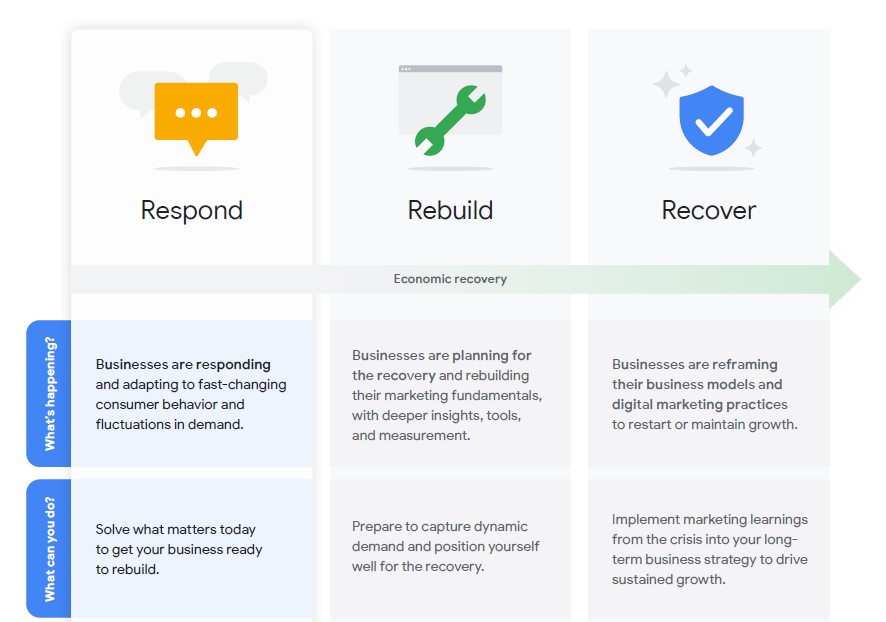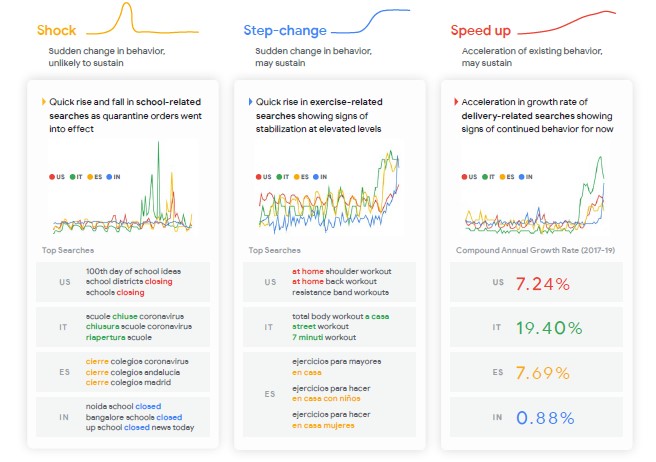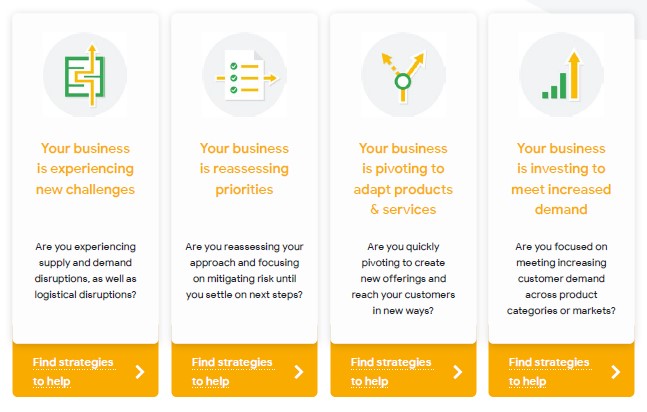Marketing online and Coronavirus, from Google here comes a manual with strategies
A pdf file of about 40 pages that contains the directions on the “path to take“, a.k.a a guide to help companies adapt marketing strategies to the new daily reality caused by the COVID-19: here is the latest news from Google to support the Web ecosystem, a real framework of activities, techniques and suggestions for all those brands that are trying to rise up.
Adapting the businesses to the Covid-19 pandemic
Covid-19 has completely changed our lives and “while we do everything we can to protect each other, our routines have basically moved on“, they write on the Thinkwithgoogle blog introducing the manual (which you can download here). “In Google we have seen companies around the world, including our own, adapt to these new realities: the timeline of economic recovery remains fluid, but there are things you can do today to act with more certainty than ever before”.
The suggestions to push forward digital marketing strategies
This is the reason behing the publication of this guide, which has the intent of “helping you to set priorities on the next things to do and take action”, through advice to the use of the latest insights on consumers and productive sectors, indications on how to evaluate the situation of your company and techniques to advance “your digital marketing strategies to meet the needs of customers” in this new reality, with many explicitly focused parts on Pay Per Click advertising and Google Ads campaigns.
According to Google, the nature of this crisis “requires us to go beyond the traditional business”: for marketing experts, “it can be an opportunity to try new strategies, think outside the box and reinvent the way we connect with the public”. And if we succeed, “the innovative and compassionate approaches we put in place have the potential to get us closer to our clients and communities”.
The three steps of the economic recovery
Although these are unprecedented situations, “we have seen companies start thinking about the path of economic recovery in three stages: respond, rebuild and rework, each with distinct priorities”, they say from Google, which explains in detail how you can outline the three stages with this mirror (again from the pdf):
· Answer
What is happening? Companies respond and adapt to the rapidly changing consumer behaviour and fluctuations in demand.
What can you do? Solve what is important today so to prepare your company for rebuild.
· Reconstruction
What is happening? Companies plan to recover and rebuild the fundamentals of their marketing, with more in-depth insights, tools and measurements.
What can you do? Prepare to capture the dynamic demand and place yourself well for recovery.
· Recovery
What is happening? Companies reformulate their business models and digital marketing practices in order to restart or maintain growth.
What can you do? Implement in your long-term business strategy the marketing knowledge that comes from the crisis so to achieve sustained growth.
“Businesses, vertical industries and markets are affected differently at each stage – some moving faster than others – but we have observed that the vast majority remain focused on the answer” and thus neglect the next two levels, but there are specific actions that you can take to achieve the goals.
Google’s guide for digital businesses at the time of Coronavirus
The manual – summed up as “a guide to help companies to adapt their digital marketing strategies and prepare for what is coming next” – is divided into three main sections (that almost seem like three commandments):
- Orient your approach with insights on consumers.
- Assess the impact on your business.
- Act.
How have consumers and their priorities changed
The section that contains insights on consumers provides guidance useful to understand how people’s behaviour has changed over these months of crisis, an extremely important element for all businesses, from small businesses that have launched into digital sales to affiliate marketers, both in collapsed niches and in more profitable programs.
The data points from which Google generates insights are the patterns in the Search system and changes in consumer behavior, as evidenced also by the synthesis that the Searchenginejournal has made of the manual.
The patterns in Google Research
Google identified three models of behaviour on its search system:
1. Shock
Sudden changes in behaviour, with peaks whose duration hardly prolong and stays consistent. The offered example is the one about searches correlated to schools closure.
2. Step-change
A sudden change in behaviour that can though last over time, as it shows signs of high-level stabilization. Examples refer to the searches about things to do at home, like workingout (we were talking about that in our analysis on the Coronavirus impact on organic searches, as well).
3. Speed up
A speed up in pre-existing behaviours, that can last and shows signs of consistency for now. Examples refer to searches correlated to delivery services.
Tools to get insights on consumers
Google suggests four tool to identify those search models that can help us find insights to apply on a marketing strategy:
- Google Trends, to discover the actual keyword search trends, segmented by dates and geographical areas; it also allows you to view the search trend (positive or negative) compared to other keywords.
- Shopping Insights, to see purchasing trends by product and brand categories.
- Google Alerts, to create a customized alert on the latest news and results for the selected keywords and topics.
- Find My Audience, which identifies a Youtube audience.
The evaluation stage of the impact on your business
Once obtained the tools and useful data we must start the response stage, which starts from the assessment of the impact of the crisis on your company and activities and, therefore, on the identification of priorities on which to focus.
The four impacts on businesses
According to Google, “each company has unique goals, so the response stage will be different for each one of them”, but there are four general models of impact which can be used to obtain more targeted indications and digital marketing strategies to support the short-term activity and, at the same time, to lay the foundations for recovery.
For each of these needs, Google recommends action paths that can be taken in the digital marketing field, particularly with specific strategies to be implemented on Google Ads, and also offers examples of action/reaction by some US brands.
Act now!
According to Big G, it does not really matter the situation your company is facing, as the key factor is always to determine your (new) priorities: the strategies and suggestions contained in the guide can help you to quickly identify the steps to be taken today to adapt your business efficiently.
For example, for brands struggling with what Google calls “new challenges” (i.e. inconveniences on offer or demand, logistical difficulties that have made operations unpredictable), the advice is to “invest in digital marketing only if it has a positive impact on your business in the next 30 days”. It might also help to think about “pausing your advertising campaigns if you experience severe volatility in supply and demand”.
Businesses that are reconsidering priorities must, on one hand, monitor the evolution of trends (in order to be resilient to issues such as liquidity management or customer fluctuations) and, on the other hand, change the business plan and adapt it to the current situation, possibly downsizing efforts in order to be present for their customers.
If the company is adapting to the new scenario, it should focus on understanding how to orient its strategy and investments accordingly: moving online products and services and profitably using technology tools can be a winning technique to be discovered online and be present for customers.
Finally, the brands that are investing to intercept the new demand may be in the right position to expand into new audiences, markets and customers. Google’s advice is to also evaluate “short and long-term marketing plans to find ways to invest in your business and meet the increased demands, serving customers in the best possible way and efficiently even in times of uncertainty”.
Google and Coronavirus, the strategies of the giant
Even Google is facing the Coronavirus crisis – according to some press rumors, the American giant is going to reduce the marketing budget by 50% in the second half of 2020 and block recruitment, also due to the collapse of investments in advertising of brands related to tourism – and uses this experience to tell the response strategy put in place.
The 5 Google principles for media campaigns after the Coronavirus
In the manual it reads that Google has changed the way it “faces media campaigns during this uncertain time” and this has provided “an idea of what resonates with customers and what does not”. To consolidate the approach, “we have developed five guiding principles for our media campaigns following the COVID-19″ which can serve as an inspiration to set strategies to respond to changing research trends and be always relevant to users.
1. Study the context
Never neglect the context. The key question to answer is localization – “is this campaign the right one, given the current context of a local market?” – because, even if we are facing a global crisis, the impacts are on a local basis and we must therefore study specific actions.
2. Constantly verify data
It is necessary to be flexible and to respond to changing trends and the question in this case focuses on the “time factor” – “We gave this campaign the green light last month, last week or yesterday: it still is the right context and moment?”. The only constant that emerges in this situation is that “things are going to change“, and then Google has reassessed “every possible point of contact of the brand through paid and proprietary channels, making video ads or automatic emails sent through Customer Relationship Management (CRM) systems”.
3. Rethink your creativity
It is also useful to ask yourself if all creative elements – tone, copys, images, keywords, placements – are appropriate to the overall situation. For example, it reads in the manual, Google does not think it is the case to use the humour and so it is “keeping its distance from some campaigns that were more fun by nature”, and also is “re-evaluating the creativity that shows interactions like handshakes, hugs and high-fives, since social estrangement is an important tactic to slow the spread of the disease”.
4. Change priorities to navigate the uncertainty
Every company should find out how to be useful by adapting to the current reality. The question that drives the action is “Which are the most relevant brands, products or campaigns that our media can support right now, and we have to shift budgets to?”. According to Google, this meant understanding that some products – such as Google Search, Youtube, Hangouts and Google Classroom – are more useful today than they were yesterday, because people turn to technology to get information or stay connected to others in these times of need. As a result, the company has shifted its “paid media priorities to brands that help more people get vital information or bridge the gap between what was once normal and their present reality”.
5. Contribute according to your possibilities
The last point invites to identify the methods or media property channels that can be useful to people and businesses in this time of need. For example, for a few weeks now, the Youtube homepage has been directing users to videos of locally relevant public health agencies or official and relevant sources on the Coronavirus theme.
Rebuild the business
If all this is part of the rapid response activity to today’s emergency and challenges, it is crucial to be reflective and strategic in the planning of recovery, to draw a path toward the future “learning from other markets and teams, both on a local basis and globally speaking”.
There are three practical tips in this regard that come from the Google manual:
1. Add the lessons of this crisis to your long-term business strategy.
Google invites you to reflect on what has worked well for your business in the response to the crisis and on what has not worked, instead, to learn from the new exclusively digital marketing efforts and to apply these techniques also to the non-digital world, to identify gaps in business processes. All this allows you to set an effective strategic approach and evaluate new marketing goals and efforts to achieve goals.
2. Invest in infrastructures that measures what is needed
In matter of results measuring it is important to prioritize metrics that bring tangible business results such as profitability. After identifying the right things to track, use them to make the measurement framework more solid: investing in a more in-depth and forward-looking marketing analysis helps us to better understand changes in consumer behaviour and anticipate demand recovery during recovery works.
3. Redefine your brand principles and re-evaluate what you need now
During this crisis, “we have seen consumers turn to brands they trust or get in touch with new brands that have offered an innovative or compassionate response to the COVID-19 emergency”, reads the document. The advice is therefore to evaluate “what your company means today to your more precious clients and to periodically reconsider if their needs have perhaps changed”, using this context to create a flexible and creative environment that allows you to react to rapidly evolving consumer behaviors and to devote time and attention to developing (or rethinking) a loyalty strategy to strengthen the love towards the brand during the recovery.






